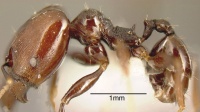Pheidole excubitor
| Pheidole excubitor | |
|---|---|

| |
| Scientific classification | |
| Kingdom: | Animalia |
| Phylum: | Arthropoda |
| Class: | Insecta |
| Order: | Hymenoptera |
| Family: | Formicidae |
| Subfamily: | Myrmicinae |
| Tribe: | Attini |
| Genus: | Pheidole |
| Species: | P. excubitor |
| Binomial name | |
| Pheidole excubitor Wilson, 2003 | |
Colonies nest beneath epiphytes in lowland rainforest (Longino 1997).
Identification
See the description in the nomenclature section.
Keys including this Species
Distribution
Atlantic lowlands of Costa Rica (Longino 1997).
Latitudinal Distribution Pattern
Latitudinal Range: 17.385° to 9.4817844°.
| North Temperate |
North Subtropical |
Tropical | South Subtropical |
South Temperate |
- Source: AntMaps
Distribution based on Regional Taxon Lists
Neotropical Region: Costa Rica (type locality), Mexico.
Distribution based on AntMaps
Distribution based on AntWeb specimens
Check data from AntWeb
Countries Occupied
| Number of countries occupied by this species based on AntWiki Regional Taxon Lists. In general, fewer countries occupied indicates a narrower range, while more countries indicates a more widespread species. |

|
Estimated Abundance
| Relative abundance based on number of AntMaps records per species (this species within the purple bar). Fewer records (to the left) indicates a less abundant/encountered species while more records (to the right) indicates more abundant/encountered species. |

|
Biology
Castes
Worker
Minor
 
| |
| . | |
Nomenclature
The following information is derived from Barry Bolton's Online Catalogue of the Ants of the World.
- excubitor. Pheidole excubitor Wilson, 2003: 687, figs. (s.w.) COSTA RICA.
Unless otherwise noted the text for the remainder of this section is reported from the publication that includes the original description.
Description
DIAGNOSIS A large, striking, bicolored member ofthe tristis group, with both major and minor possessing short, sparse, erect pilosity and a prominent humerus that rises far above the relatively flat promesonotum in dorsal-oblique view. Mesonotal convexity greatly reduced in major and absent in minor. In both castes, postpetiolar node seen from above bell-shaped, and prominent rounded postpetiolar process present.
Similar to Pheidole alpinensis, Pheidole exarata, Pheidole germaini, Pheidole grandinodus, Pheidole obrima, Pheidole rogeri, Pheidole severini, Pheidole stulta, Pheidole tristis and Pheidole zoster, differing in many details of body form, sculpturing, and pilosity as illustrated, and in color.
MEASUREMENTS (mm) Holotype major: HW 1.56, HL 1.74, SL 0.84, EL 0.20, PW 0.80. Paratype minor: HW 0.70, HL 0.74, SL 0.76, EL 0.16, PW 0.46.
COLOR Major: waist and gaster blackish brown, contrasting with the yellowish red of the remainder of the body; appendages a darker shade of reddish yellow.
Minor: gaster medium brown, contrasting with the reddish yellow ofthe rest ofthe body and appendages.
Figure. Upper: holotype, major. Lower: paratype, minor. Scale bars = 1 mm.
Type Material
COSTA RICA: La Selva Biological Station, near Pueblo Nuevo, Heredia, 150 m, col. John T. Longino. Instituto Nacional de Biodiversidad
Etymology
L excubitor, guard, sentinel.
References
- Wilson, E. O. 2003. Pheidole in the New World: A dominant, hyperdiverse ant genus. Harvard University Press, Cambridge, MA. (page 687, fig. major, minor described
References based on Global Ant Biodiversity Informatics
- Branstetter M. G. and L. Sáenz. 2012. Las hormigas (Hymenoptera: Formicidae) de Guatemala. Pp. 221-268 in: Cano E. B. and J. C. Schuster. (eds.) 2012. Biodiversidad de Guatemala. Volumen 2. Guatemala: Universidad del Valle de Guatemala, iv + 328 pp
- Fernández, F. and S. Sendoya. 2004. Lista de las hormigas neotropicales. Biota Colombiana Volume 5, Number 1.
- Longino J. T. L., and M. G. Branstetter. 2018. The truncated bell: an enigmatic but pervasive elevational diversity pattern in Middle American ants. Ecography 41: 1-12.
- Longino J. et al. ADMAC project. Accessed on March 24th 2017 at https://sites.google.com/site/admacsite/

